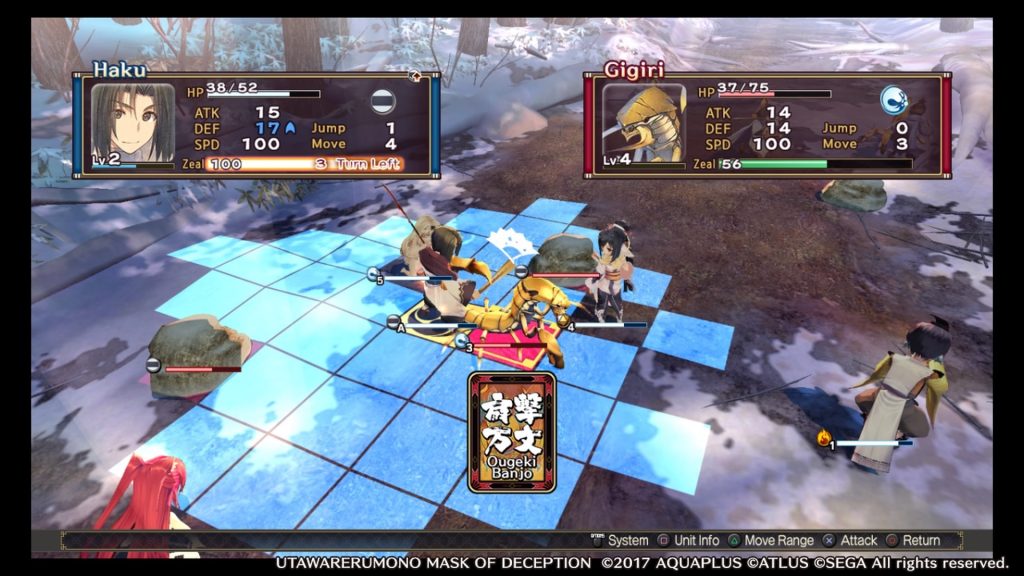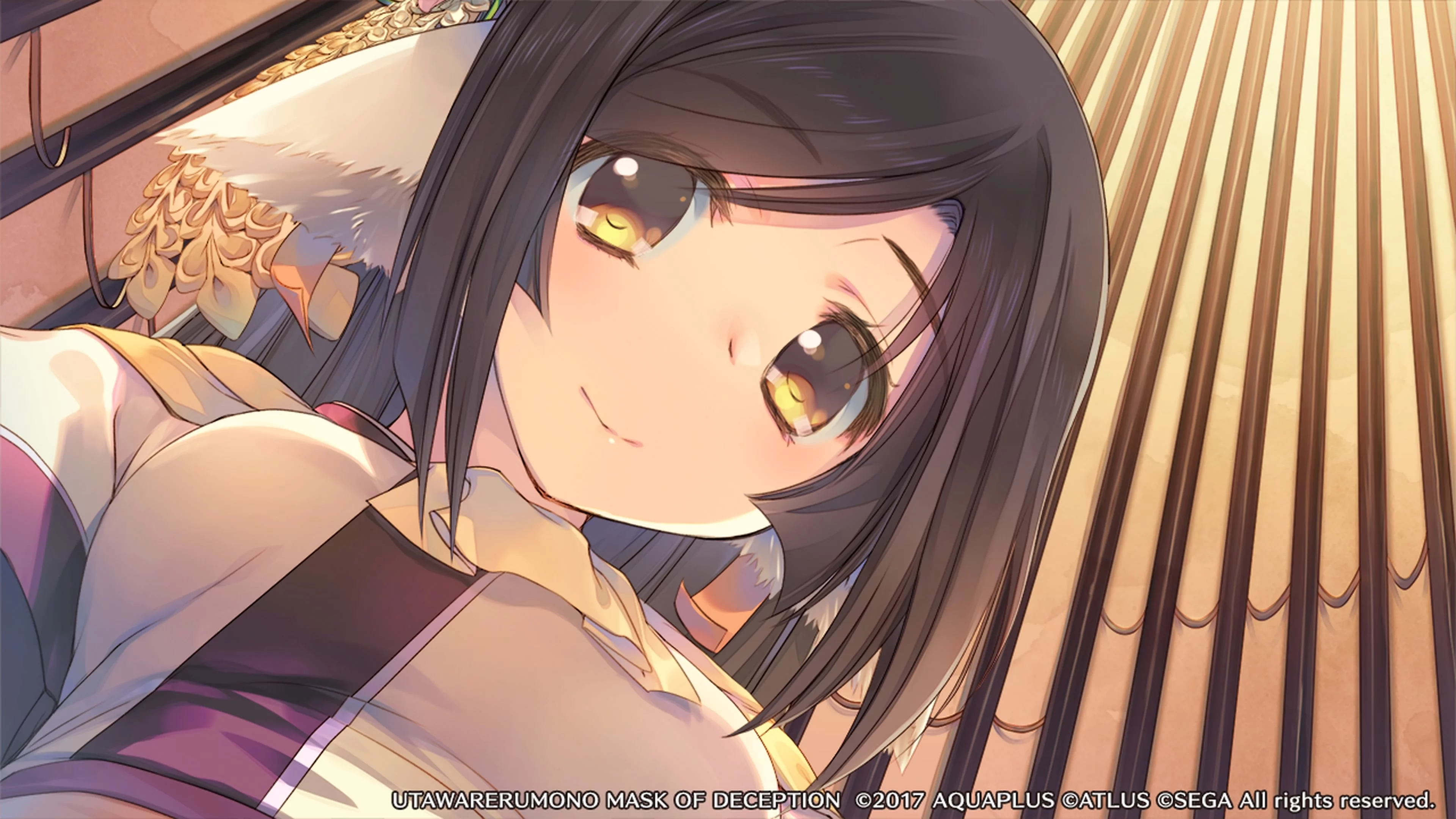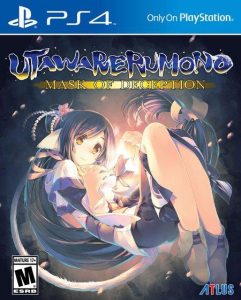I haven’t played a lot of visual novels – aside from Super Robot Wars V. Utawarerumono: Mask of Deception, like SRW V, is a hybrid of a visual novel and a tactical RPG, though one with a more linear narrative to it.
The End is the Beginning
It is important to mention first that Utawarerumono: Mask of Deception is a sequel. The first game, Utawarerumono, was a fantasy story that over the course of the work had the twist that it was actually a work of post-apocalyptic SF, with a world that was heavily influenced by the Japanese Ainu culture.
Mask of Deception puts its post-apocalyptic fantasy foot forward but shifts the tone of the story from less “Ainu” and more “Yamato” – literally. The protagonist of the story, Haku, is a human from before the apocalypse, who was cryogenically frozen before everything went bad. He is awoken with amnesia by Kuon, the daughter of the protagonist of the first game and one of the possible romantic interests (presumably Erurū).
Haku is nursed back to health by Kuon, and he, along with several other women, travel to the capital and end up getting wrapped up in various political maneuverings. In the process, they become friends with one of the main generals in the Imperial government – Oshtor – and end up obtaining the favor of the Mikado – the God-Emperor of the country.
So, if it’s not entirely clear from that summary, the world of Mask of Deception is definitely more culturally inspired by Heian Japan, complete with (along with the name of the Emperor) naming the country “Yamato”. Also interestingly – the location of “Yamato” isn’t in the Japanese islands – that’s the country from the first game (and which Yamato attempts to invade over the course of the game and fails). The country of Yamato is in the Korean Peninsula, which is where the Yayoi (who are believed to be the genetic predecessors of the “Yamato People”) is believed to be from.
Railroading
As far as the game itself goes – unlike SRW V this story is completely linear. There are no screens where you make a narrative choice in the story, and the game doesn’t branch the narrative depending on how combat plays out in the game. This definitely reduces the amount of replay value in the game – you play through the game once and you’re going to see everything the game has to offer.
That said, the story of Mask of Deception is very engaging and the visual novel scenes are very well executed. The art is very well done with plenty of various splash screens to illustrate chunks of the story. Additionally, the game is fully voiced (in Japanese only – no English dub), with some great music on top of that, which helps give a sense of the various scenes.
It’s just that I would have liked to have some semi-branching paths, to flesh out the story and the characters a little more. Even if it was just having the option to take some branching conversation paths that could potentially unlock another combat scenario focusing on another party member would have been nice – either hunting for herbs with Kuon, or getting into trouble with Nosuri and her brother, or Atuy looking for love and a good fight (not necessarily in that order).
To Arms!
The tactical RPG scenarios are fine, with the maps having interesting and engaging terrain. A few scenarios are also based around luring enemies to particular environmental elements or attacking certain environmental objects to trigger an event to cause a victory. There is a definite sense that if you haven’t already out leveled particular combat that you need to give some thought for your strategy for each combat. That said, I didn’t have too many problems getting through the game’s combat scenarios, though there were a couple of moments in the late game that was a pretty close run thing.

The RPG mechanics are still fairly basic – you get a few Build Points after completing combat scenarios to improve your HP, Attack, Defense, and Speed stats – and that’s it. No options for trying to increase your characters’ movement, and any item upgrades you receive give your characters additional passive abilities, but nothing much in terms of additional combat verbs.
To the game’s credit, it does help mitigate some of this by not having an MP resource to manage on top of everything else. Instead, you’ve got a “Spirit” stat, which maxed will allow additional actions, and if you’ve leveled up enough will allow the character to do a “Final Strike” which will deal a bunch more damage, at the cost of draining the entire gauge.
Where the resource management mechanics come in here is that some of your attacks will build the meter, and others will drain it – making for a question of whether you want to use a buff or debuff ability that will help you out in combat at the risk of draining your meter. Do you use a healing ability now that won’t drain your meter, but also won’t build it – when an attack will max the meter and grant you an extra turn to possibly take out two enemies, for example.
That said, the combat isn’t without some degree of BS. One of the post-game combat scenarios puts you against a group of mages all of whom have some sort of “Escape Death” ability, where if the characters take enough damage to kill them, then they regenerate a small amount of HP – just enough to keep them in the fight.
Now, I won’t cry foul too loudly over this, there are a couple of items you can get to give party members a more aggressive version of this ability (where the character’s HP is completely regenerated). That said, when it comes to dealing with enemies, it would be nice if there was some way to get around their version of the ability – it’s not an ability you can really adjust your tactics for, you just have to brute force through it – which I wouldn’t exactly consider fun.
Game The Game
Still, Mask of Deception works incredibly well, narratively, and it creates a world that, frankly, I’d really like to adapt into a tabletop RPG campaign (something that I mentioned in my review of the original Oriental Adventures book for AD&D 1e).
I’m just not sure which system would work quite yet – I’d like a little more crunch than what FATE or the various incarnations of Apocalypse World system has to offer. With some expansions, Pathfinder 2nd edition could work, as could Savage Worlds and maybe D&D 5e with some re-skins of abilities. I’d want to read more of Cypher System and Numenera before I think about giving that a reskin.
Whatever system that you’d use would need to be something that would have a significant number of options for doing an anime-Chambara style of game, with characters having special abilities that escalate in their flash, along with having spellcasting characters that, while being squishy, are less of a glass cannon and more of a glass pump-action shotgun – able to get a few shots off, and who aren’t utterly magically defenseless in combat once they’ve shot off their big round.
In all, I really enjoyed Mask of Deception, but it also really bears mentioning that the game, perhaps unlike the original, ends on a heavy sequel hook. The final game in the series Mask of Truth is already out in English as well – so if you find yourself enjoying Mask of Deception, you may just want to jump on picking up that game as well.
Utawarerumono: Mask of Deception is currently available for the PS4 from Amazon.com, and at a very reasonable price. There’s a launch edition of the game which also came with an art book which you can find on eBay. Buying anything through those links helps to support the site.



A fine review. You might look at The Blossoms Are Falling, an Asian fantasy supplement for Burning Wheel, for the basis of your tabletop reskin. Best of luck.